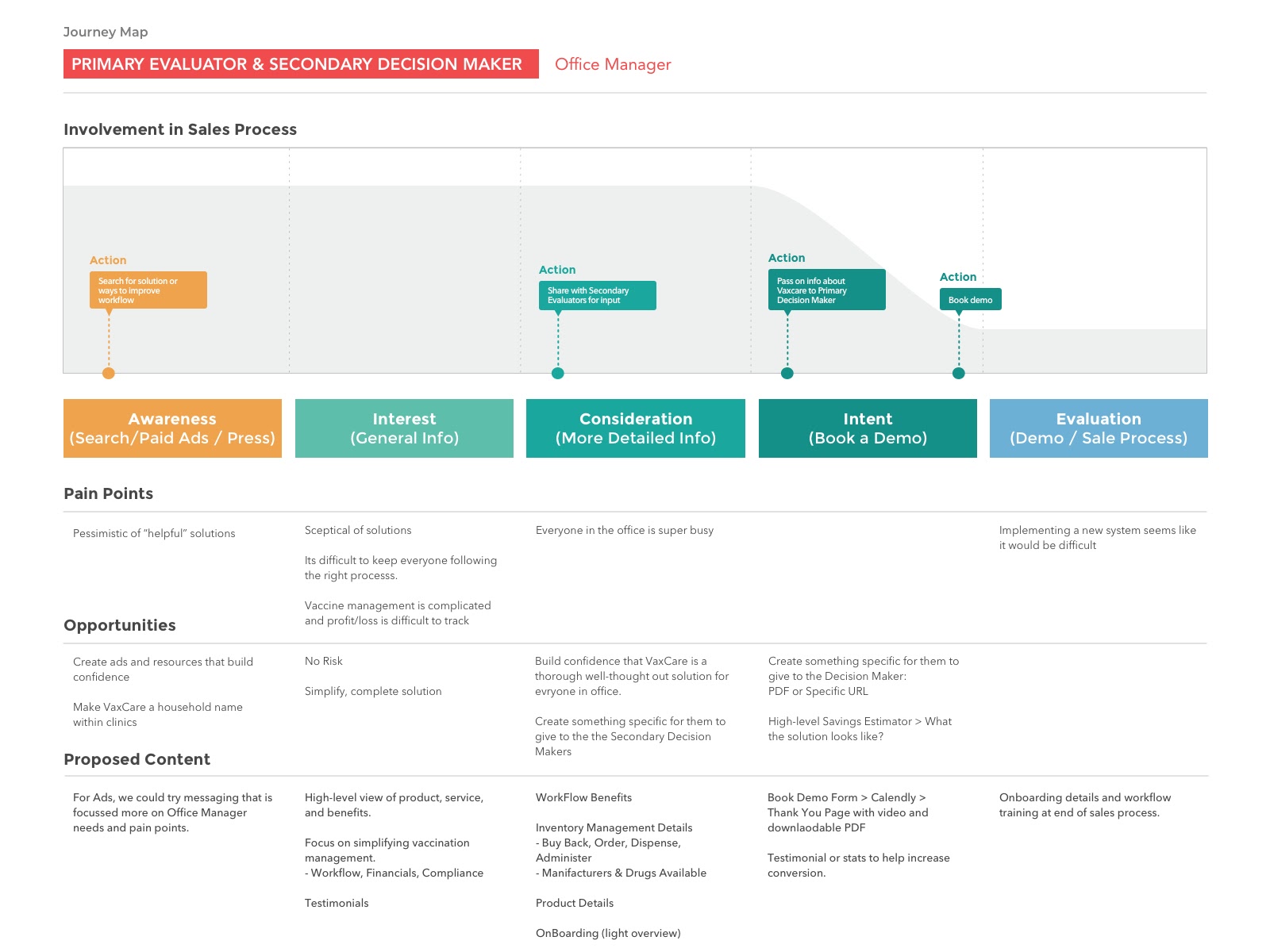In a post-COVID world, most sales organizations are moving from a strictly traditional sales process to incorporating digital marketing. As you focus on your move to digital, it’s important to identify who is searching for your product, who is making the buying decision, and how to design for them.
Many organizations, especially those investing in B2B software, will have one person researching software solutions, while another person is the final decision maker. The researcher is oftentimes a mid-level manager with first-hand experience of how the proposed solutions will directly affect day-to-day operations. The decision maker, on the other hand, will likely be less focused on daily processes and more focused on high level issues like buying decisions.
In a traditional sales process, most tactics focus on trying to get past the researcher or gatekeeper. However, a more successful route involves digital marketing to win over and empower the researcher to champion your product through to the final decision maker.
Create a Buying Journey Map
Journey maps are traditionally used in UX design to easily understand how users interact with a service or product throughout its touch-points. At OM, we like to apply the same thought process to how leads travel through the buying journey before becoming customers. (Note: If you haven’t involved your design team in your sales process, now is probably a great time!)
A buying journey map should follow the same key stages as your sales and marketing funnel, from initial awareness through the final decision of a purchase. The example below is for a 5-step funnel, but you should tailor it to your existing processes.

(There are plenty of online tools like LucidChart that can help you get started).
Identify the Key Players
It’s important to understand exactly who you are marketing to, so you can target their specific needs at the right point in the buying journey. All industries are different, but they likely have two main important players in the sales experience.
The Researcher(s): Typically someone just under the decisions maker on the org chart, this is the person tasked with the initial search for solutions to the problems within the organization. The research phase likely starts digitally with an internet search, but can also be supported through direct mail, ads, or conferences.
The Decision Maker(s): For smaller organizations this is typically the CEO, President, or Business Owner. For larger organizations, it’s likely a Vice-President or Director, or even value analysis committees (VACs). If your solution is less expensive software, the decision maker may be an office manager or department head. Note: Some buying decisions may require multiple decision makers that include accounting and operations to approve a purchase.
Map Out the Flow of Information
Create a journey map for each of the people identified as a key player. Each one of these people will be a part of the sales process, and you’ll likely have to win each one over while working up the chain of command.
For each stage of the buying journey identify key pain points and opportunities on how to win over the key player. Pain points are the reasons why they are looking for, or need, your product. Opportunities are ways in which you can position your solution and present that information to them.
Each key player will have different needs and pain points, so you can start to plan on how to target and speak to each. For example, you may be selling to the Researcher on the ease of use and best in class customer support. While also selling the final decision maker on cost savings and no long term commitments.
Make the Researcher Your Champion
The goal here is to increase touch-points with the Researcher and win them over to love your brand and mission. It’s important to not hard sell them on your product (afterall, they aren’t the decision maker), but to build trust and confidence that your company is THE expert in the space. Content can include helpful guides, ebooks, and webinars to help them succeed at their job.
Relevancy and Specificity: Reference your Researcher journey map. Use the opportunities and pain points under the first half of the buying journey as a jumping off point to brainstorm the content and messaging for campaigns.
For instance, if you know the Researcher is an Office Manager with a pain point of being overworked, your ad messaging could be “The Top Time Saving Software Rated by Office Managers”. If a pain point is data entry into spreadsheets, you could create a blog about “7 Secret Tips to Mastering Data in Spreadsheets.”
Branding: Now that you have the correct messaging, make sure that all of the content you create is well branded with your company name and logo. Again, don’t try to shamelessly oversell your product at this stage. Rather, focus on improving the Researcher’s current job and workflow while building awareness and trust with your brand. Make sure your logo and colors are prominent on all marketing materials. Distinct and memorable imagery will also help set you apart from the crowd.
Consistency: It will take more than one touchpoint for anyone to start to notice and trust your brand, so make sure that your brand’s visual language (color, logo, and style of imagery) are consistent across ads and campaigns.
Best practices to design for the Researcher:
- Speak to the specific pain points of the Researcher.
- More specific is always better. (Pro Tip: Use dynamic headlines on LPs.)
- Build trust by using testimonials from people with similar job positions as the Researcher.
- Brand any resources with your logo and link to your website.
- Don’t be too salesy pushing your own product. Focus on building value and trust instead.
Empower the Researcher to Sell for You
Now that the Researcher trusts and follows your branded content, they are ready to be your advocate in pitching your product or service to the Decision Maker. Researchers are rarely wired like a traditional sales rep, so its key to create fail-proof content and workflows that the Researcher can easily use to help win over the Decision Maker.
With the Researcher as your advocate, the goal is for them to influence the Decision Maker to reach out to contact a sales rep or book a demo – whatever the action is in your organization that activates your company’s sales process. The best way to make this happen is to eliminate any barriers or questions. (Your Journey Map for the Decision Maker should highlight what these typical sticking points are).
Online pricing or savings tools: Price is often the main sticking point for a Decision Maker. Create a landing page the Researcher can share with a widget that easily shows how much your product will cost them and how much they may actually save by using it.
PDF downloads: Sell sheets may seem antiquated in the digital world, but it’s an easy way for you to control exactly what the Decision Maker should see, and easy for the Researcher to share via email or print out.
Case Studies: Create online case studies that are easily shareable. Have CTAs on your blog posts and content that leads the Researcher to the case studies.
Easy to Access Demos: Avoid the back and forth of scheduling a call or filling out a long form. Use a tool likely Calendly to quickly and easily book demos or have a pre-recorded video demo as an option for an immediate response.
Conclusion
Without a well thought out plan, you are often leaving the Researcher to digest your content, pull out what they think are the key highlights, and then pass that information on to their Decision Maker. It can be a messy game of telephone with the final message being relayed very differently than the original.
Instead, use a journey map to visualize the process and create a cohesive strategy. Deliver thoughtfully designed content for the Researcher to build a relationship and trust with your brand. Then include timely and easy to find CTAs that allow the Researcher to share your story with the Decision Maker.



